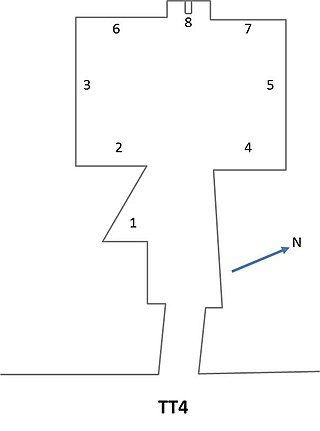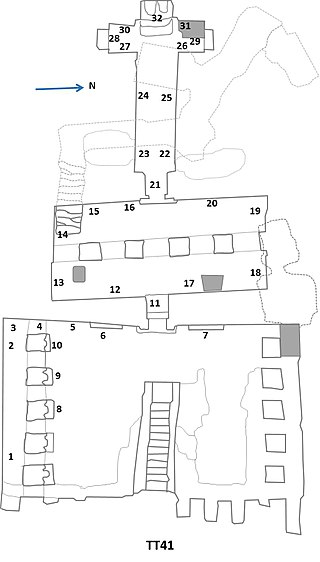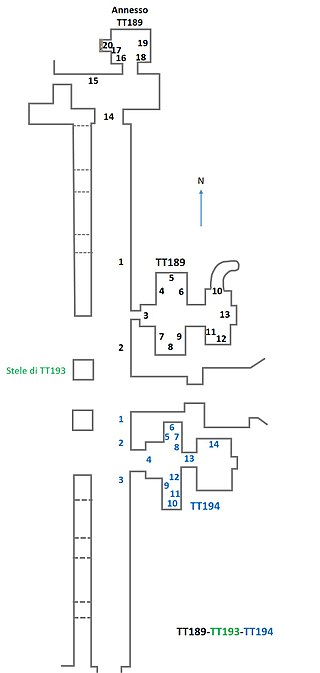
The Theban Tomb TT4 is located in Deir el-Medina, part of the Theban Necropolis, on the west bank of the Nile, opposite to Luxor. It is the burial place of the ancient Egyptian artisan named Qen.
Qen was an Ancient Egyptian artisan. Qen lived in Deir el-Medina on the west bank of the Nile, opposite Thebes, during the reigns of Ramesses II. His titles included Servant in the Place of Truth, meaning that he worked on the excavation and decoration of nearby royal tombs. He was buried in a tomb in the village necropolis.
Nebwenenef was High Priest of Amun at the beginning of the reign of Ramesses II during the 19th Dynasty. Prior to that, Nebwenenef had served as High Priest of Anhur and High Priest of Hathor during the reign of Seti I and possibly even earlier.

The Theban Tomb TT41 is located in Sheikh Abd el-Qurna, part of the Theban Necropolis, on the west bank of the Nile, opposite to Luxor. It is the burial place of the ancient Egyptian Amenemopet called Ipy, whose title was Chief Steward of Amun in the Southern City. He dates to the time of Ramesses I, Sethi I and Ramesses II from the Nineteenth Dynasty of Egypt

The Theban Tomb TT58 is located in Sheikh Abd el-Qurna, part of the Theban Necropolis, on the west bank of the Nile, opposite to Luxor. The tomb was originally carved for a courtier dating to the time of Amenhotep III and later usurped during the Ramesside period.

The Theban Tomb TT137 is located in Sheikh Abd el-Qurna. It forms part of the Theban Necropolis, situated on the west bank of the Nile opposite Luxor.

The Theban Tomb TT138 is located in Sheikh Abd el-Qurna, part of the Theban Necropolis, on the west bank of the Nile, opposite to Luxor.

The Theban Tomb TT156 is located in Dra' Abu el-Naga', part of the Theban Necropolis, on the west bank of the Nile, opposite to Luxor. It is the burial place of the ancient Egyptian Pennesuttawy, who was a troop commander and superintendent of the Southern Desert Lands during the reign of Ramesses II in the Nineteenth Dynasty.
Pennesuttawy was a Military Commander and Superintendent of the Southern Lands (Kush) during the beginning of the Nineteenth Dynasty of Egypt.
The Theban Tomb TT170 is located in Sheikh Abd el-Qurna, part of the Theban Necropolis, on the west bank of the Nile, opposite to Luxor. It is the burial place of the ancient Egyptian Nebmehyt, who was a scribe of recruits of the Ramesseum in the Estate of Amun during the reign of Ramesses II in the Nineteenth Dynasty.

Tomb TT189 is located in the necropolis of El-Assasif in Thebes, Egypt. It contains the sepulchre of Nakhtdjehuty, who was an overseer of the carpenters of the northern lake of the god Amun and the head of the goldworkers in the Estate of Amun during the 19th Dynasty reign of Ramesses II. Nakhtdjehuty's tomb is part of the TT192 tomb complex.

The Theban Tomb TT177 is located in El-Khokha, part of the Theban Necropolis, on the west bank of the Nile, opposite to Luxor.

The Theban Tomb TT178 is located in El-Khokha, part of the Theban Necropolis, on the west bank of the Nile, opposite to Luxor.

The Theban Tomb TT214 is located in Deir el-Medina, part of the Theban Necropolis, on the west bank of the Nile, opposite to Luxor.

The Theban Tomb TT385 is located in Sheikh Abd el-Qurna, part of the Theban Necropolis, on the west bank of the Nile, opposite Luxor. It is the burial place of the ancient Egyptian Hunefer (Haunefer), who was a Mayor of the Southern City (Thebes) during the reign of Ramesses II in the Nineteenth Dynasty.

QV80 is the tomb of (Mut-)Tuya, the Great Royal Wife of Seti I, and the mother of Ramses II, in Egypt's Valley of the Queens.
Nakhtmin was a Troop Commander of Kush and Royal Envoy to Every Foreign Land during the reign of Ramesses II.

Tomb TT374, located in the necropolis of El-Khokha in Thebes, Egypt, is the tomb of the Scribe of the Treasury of the Ramesseum, Amenemope.
The Theban Tomb C.7 is an ancient Egyptian tomb in Thebes, Upper Egypt. It is located in Sheikh Abd el-Qurna, part of the Theban Necropolis on the west bank of the Nile opposite Luxor. It is the burial place of the ancient Egyptian Horimose (Harmosi), who was the Head custodian of the treasury in the King's Mansion on the West of Thebes. Horimose, his wife Mutemwia, and a son named Kaemwaset are named in scenes in the Hall of the tomb. One of the scenes shows a row of kings including: Horemheb, Amenhotep III, Thutmosis IV, Amenhotep II, Thutmosis III, Thutmosis II and Thutmosis I.
Amenmose, Son of Pendjerty was a royal scribe from the time of Ramesses II. Amenmose was the son of the judge Pendjerty and the sistrum bearer of Amun, Mut and Khonsu, named Mutemonet.












